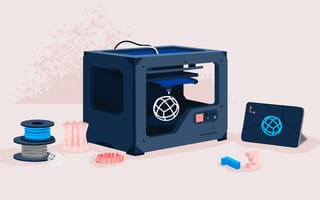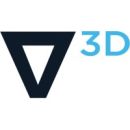Think of 3D printing as erosion in reverse. While bodies of water wear substances down layer by layer, 3D printers build substances up in a similar way. This provides a unique object creation process that can be quick, cost-effective and low-waste in comparison to manual construction.
Due to these feats, 3D printing is a thriving, multi-billion dollar market. Modern 3D printers range from desktop models to industrial giants to “bioprinters” that create human tissue. That’s not to mention 3D-printing software, where objects get designed and optimized, as well as have their own on-demand printing shops.
Top 3D Printing Companies to Know
- Desktop Metal
- Markforged
- Xometry
- Stratasys
- 3D Systems
- Protolabs
- Nano Dimension
Here are some companies thriving in the 3D printing space.
3D Printing Companies to Know
How Autodesk uses 3D printing: Autodesk, known for its design and engineering software, also hosts software specifically for additive manufacturing. Its Netfabb software is meant for additive manufacturing design and simulation, while its Fusion CAD software helps model 3D designs for product development, machining and more. Autodesk is utilized by companies like Toyota, Logitech and Panasonic among others.
How HP uses 3D printing: Known for its PC and related hardware, HP also offers personal 3D printers as well as 3D-printing software, services and varied materials. HP’s Jet Fusion printer series are multi-material compatible and scalable to manufacturing needs. The company’s 3D printing services have come in handy for industries ranging from aerospace to consumer goods and electronics.
How Desktop Metal uses 3D printing: Desktop Metal condensed a steel mill into a box smaller than a refrigerator that easily fits through an office door. No special ventilation is required, and there’s no open flame, laser light or loose powder involved. It just needs power and an internet connection to 3D-print with steel. More specifically, this company’s printer extrudes rods of a powdered steel alloy, wax and polymer binder. (The company is developing copper and nickel filaments, too.) The printer first cooks away the binding. It then welds steel layers together in its furnace. Though it’s a very contained process, it’s also transparent — users can watch it unfold via livestream.
How Markforged uses 3D printing: Many 3D printers use plastic filament, but not those made by Markforged. Its industrial printers can print hardier substances, including nylon, carbon fiber and even metal — hence the “forge” in Markforged. (Continuing the metal theme, it also makes AI manufacturing software called Blacksmith.) Integrated into factories worldwide, this company’s printers reportedly have helped transform supply chains by accelerating prototype and replacement part manufacturing.
How Xometry uses 3D printing: Xometry began as a way to simplify prototyping. Its software eliminated the need for companies to slowly and laboriously gather quotes from manufacturers. Instead, they could access six different types of 3D printers on demand and at instantly-quoted rates. That model has attracted high-profile clients like car manufacturer BMW, which relies on Xometry for custom trim, logos and other unique and tooling-heavy touches that are printed from carbon fiber tubing.
How Shapeways uses 3D printing: Shapeways 3D prints designs on demand in a choice of more than 120 materials, including plastic, sandstone and platinum. Customers simply log in to the site, upload a design and place an order, which prints in one of the two Shapeways factories and arrives via mail. It’s online shopping, really, but instead of browsing the wares, shoppers design them. Shapeways also has a team of designers on hand to help users bring their visions to fruition.
How Velo3D uses 3D printing: Velo3D develops 3D metal printers and 3D print preparation software for use in the aerospace and energy industries. Its Sapphire family of printers are able to build additive manufacturing models layer-by-layer using powder bed fusion. As for designing parts, Velo3D offers its Flow software, which allows the import of native CAD models and full design freedom to manipulate, orient and label 3D print parts.
How nTop uses 3D printing: Formerly nTopology, nTop’s NTop Platform can be integrated into 3D printing engineering workflows. A standout feature: It can autonomously tweak and streamline existing designs, removing clunkiness and excess weight so designers can focus on more important problems and avoid busywork — whether they’re printing medical devices or rocket nozzles.
How Divergent uses 3D printing: Divergent aims to streamline and decentralize car manufacturing. That means moving production out of multi-million-dollar factories and into a networked cluster of 3D printing shops. In these smaller, warehouse-like spaces, the Divergent 3D team relies on end-to-end design software and industrial printers to create light, safe, fast cars.
How SprintRay uses 3D printing: SprintRay is a 3D printing company specializing in dental products. The company’s RayWare software is specifically designed with dental professionals in mind as it pairs CAD automation and allows for connection to SprintRay’s printers, making modeling dental products more streamlined. The software also allows users to save edited models and export to other CAD services. In addition, SprintRay offers a host of 3D dental printers as well as cloud solutions that reduce the need for hardware and allow for more mobile printing.
How Glowforge uses 3D printing: This company’s namesake 3D printer, Glowforge, can print with almost any material. Kid-friendly and intended for home use, it creates custom designs from plastic, wood and even chocolate. Though it allows for creativity, that’s not required; the hardware comes pre-loaded with a catalog of cool designs for everything from monogrammed macarons to a wooden Settlers of Catan game board.
How Mighty Buildings uses 3D printing: Mighty Buildings focuses on 3D-printed buildings and communities. Specifically, this company makes tiny-house-esque “backyard studios” with a massive printer that barely fits in a warehouse. The company offers multiple studio models that can max at over 1,000 square feet, outfitted with floor-to-ceiling windows and working bathrooms.
How GE uses 3D printing: The GE Additive team specializes in hardware, software and consulting services for 3D-printed metal parts. Utilizing direct metal laser melting and electron beam melting processes, the company’s additive machine hardware melt and layer metal powders to build custom part solutions. GE Additive products have created parts for use in orthopedic implants, aircrafts, automobiles and industrial manufacturing tools.
How Stratasys uses 3D printing: Stratasys has been in the 3D printing industry since 1988 — almost as long as 3D printing has existed. During that time, it has racked up more than 250 granted or pending patents worldwide. Today, the company helps clients like Audi and Lockheed Martin perfect their manufacturing process with 3D printing. It also manufactures printing hardware for Hewlett-Packard as well as its own brands. Ever the industry leader, Stratasys remains on the cutting edge, especially when it comes to recycling. Clients can send used cartridges, print engines and other parts back to the company for green disposal.
How 3D Systems Corporation uses 3D printing: The original 3D printing company remains on the cutting edge of the field. 3D Systems Corporation makes a broad spectrum of 3D printers, which work via stereolithography, a liquid-to-solid process, and a powder to solid process called selective laser sintering. Printers make everything from metal artifacts to plastic filaments to custom dental implants. 3D Systems also offers a constellation of related products, like 3D scanners and design software.
How Protolabs uses 3D printing: Protolabs speeds up the manufacturing process. As its name suggests, the business began as a quick-turnaround prototyping company. In 2014, however, it added a 3D printing shop to speed the transition between the prototyping phase and small batch testing. That shop now has more than 100 printers that can print metal, plastic and other materials.
How Nano Dimension uses 3D printing: Nano Dimension’s combines 3D printing products with AI to create streamlined 3D-printed circuits and devices. Imbued with its DeepCube neural network, the company’s printers are able to detect and correct manufacturing errors in real-time, improving part quality and reducing material costs. In addition, Nano Dimension hosts surface-mount technology hardware and software for automated assembly needs.
How Materialise uses 3D printing: Materialise focuses on 3D printing software, which makes complex printing hardware accessible to engineers, healthcare professionals and even fashion designers. Designer Anoul Wipprecht, for example, used Materialise software to print a surreal, bubble-wrap-like dress that also tracks the wearer’s mood. The company’s comprehensive digital suite includes tools for drafting and optimizing designs, controlling printers mid-job and managing 3D printing workflows.
How Carbon uses 3D printing: Every 3D printing process involves fusing layers into a whole, but Carbon has reinvented the fusing process. Called Digital Light Synthesis, the technique smooths away the “seams” that 3D printing often produces. This creates a seamless finish, and a stronger product — traditionally 3D-printed objects’ strength can vary, depending on whether the nozzle moved clockwise or counterclockwise in production.
How MakerBot uses 3D printing: Though MakerBot printers have many industrial applications, the company also makes a newbie-friendly desktop printer, the Replicator+, that’s meant for schools. Makerbot complements that popular hardware with free lesson plans that incorporate 3D printers and are available via download or book form. In one suggested earth science lesson plan, for instance, students print models of different cloud types to literally grasp the distinction between cumulus and cirrus. And that’s just one of the new options Replicator+ opens up for students who learn best through touch and action.
How CELLINK uses 3D printing: CELLINK focuses on “bioprinting,” the 3D printing of bone, cartilage, and, maybe someday, functioning human organs. Any and all of that is possible with the company’s patent-pending universal bioink — a soup of stem cells and alginate derived from brown seaweed. The company also makes complementary technology: 3D printers, software and specialty inks designed for specific types of tissue.
How Rokk3r uses 3D printing: Rokk3r has helped various companies streamline their business plans with “exponential technologies.” (That means tech that helps them outperform competition by a factor of at least ten.) Those technologies include blockchain, Internet of Things connectivity, and, you guessed it, 3D printing. The latter can exponentially reduce the number of parts required in complex manufacturing, which accelerates and simplifies the whole process.
How Organovo uses 3D printing: With 3D-printed tissue, this company takes lab testing to the next level. Organovo’s bioprinting technology builds fabricated multicellular tissues, giving a wider three-dimensional view of cellular function and structure in comparison to views in a two-dimensional petri dish. Specialists can utilize these tissue creations to assess pharmacology and structural factors of a disease, and have already been able to simulate liver, kidney, bone and other cellular environments.
How Fast Radius uses 3D printing: Fast Radius, acquired by SyBridge Technologies, has replaced old-school, centralized factories with a network of smaller “manufacturing lighthouses” — a move for which the company was named one of the globe’s leading factories by the World Economic Forum. At each of its fabrication plants, the company 3D-prints and injection-molds parts for industrial use and quickly ships them off. Its partnership with UPS, paired with the company’s distributed structure, means it can often offer next-day delivery, even on custom builds.
How Fortify uses 3D printing: Fortify relies on a magnetic system that arranges reinforcement fibers with a digital light processor. By arranging the fibers in the object, Fortify can create high-strength tools for engineers. So far, the company’s products include FLUX printers, materials, software and applications.
Frequently Asked Questions
What is 3D printing?
3D printing, a form of additive manufacturing, is the process of printing three dimensional objects from a digital file. 3D-printed objects are often designed using CAD (computer-aided design) software, and printed layer-by-layer with plastic, resin, powder, metal or carbon fiber materials.
What are the top 3D printing companies?
Stratasys, 3D Systems, GE and Protolabs are some of the top 3D printing companies leading the industry.
How much does it cost to 3D print an object?
3D printing an object can cost from a few cents up to thousands of dollars, depending on the object's size, materials used and whether it was printed at home or through a service.


















